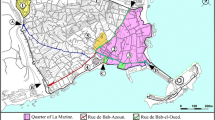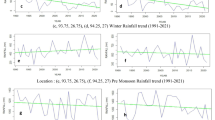Abstract
This paper presents the results of a study on historical cliffs recessions using GIS. In this study, a GIS methodological approach was developed to model and analyse the development and spatial distribution of cliff recession on the coast at Dakar. Valuable information about the coastal erosion and the main causes of the instabilities was obtained. Finally, this research also suggests that important information regarding instability processes can be gathered from existing information sources, such as technical maps, aerial photographs, and written documents, thereby limiting the need for costly and time-consuming field and/or laboratory investigations.
Résumé
Cet article présente les résultats d’une étude portant sur l’analyse des retraits historiques de falaises à l’aide du SIG. Dans cette étude, une approche méthodique utilisant le SIG a été développée afin de modéliser et d’analyser le développement et la distribution spatiale des retraits de falaises sur la côte de Dakar. De précieuses informations sur l’érosion côtière et les causes des phénomènes d’instabilité ont été obtenues. Finalement, cette recherche montre aussi que d’importantes informations concernant les phénomènes d’instabilité peuvent être déduites des sources d’information existantes, telles que des cartes techniques, des photographies aériennes, et des documents écrits. Ceci permet de limiter le besoin de réaliser de travaux de terrain coûteux en temps et argent.













Similar content being viewed by others
References
Bellion Y (1980) Histoire géodynamique post-paléozoïque de l’Afrique de l’Ouest. D’aprés l’étude de quelques bassins sédimentaires (Sénégal, Taoudenni, Iullemmeden, Tchad). Thèse doctorat es Sciences Univ. d’Avignon et des pays de Vaucluse, pp 222
Carrara A, Guzzetti F (eds) (1995) Geographical information systems in assessing natural hazards. Kluwer, Dordrecht, p 353
Carrara A, Cardinali M, Guzzetti F (1992) Uncertainty in assessing landslide hazard and risk. ITC J 2:172–183
CEREEQ (1976) Étude des fondations et reconnaissance des sols. Région de Dakar—Première phase. Rapport, p 75
Cruden DM, Fell R (1997) Preface. In: Proceedings of the international workshop on landslide risk assessment. Balkema, Rotterdam, pp 19–21
Dia A (1980) Contribution à l’étude des caractéristiques pétrographiques, pétrochimiques et géotechniques des granulats basaltiques de la Presqu’île du Cap-Vert et du plateau de Thiés. Thèse 3e cycle Univ. Dakar, p 183
Elouard P (1980) Excursion géologique, sous-sol de Dakar. Notes Afr (Dakar) 105:2–12
Fall M (1993) Étude de la stabilité du versant naturel des Madeleines. Ing. Thesis, IST, UCAD, p 50
Fall M (2000) Standsicherheitsanalyse der Küstenhänge in Cap Manuel (Dakar, Senegal) mit Hilfe ingenieurgeologisch-geotechnischer Unter-suchungen und GIS-technologischer Methoden. J of Wissen. Mit. of Inst Geot Heft no 2000-2, p 187
Fall M, Azzam R (1998) Application de la Géologie de l’Ingénieur et de Systèmes d’Information Géographique à l’étude de la stabilité des versants côtiers du Cap Manuel. In: Proceedings of 8th congress IAEG, British Columbia, pp 1111–1118
Fall M, Azzam R (2000) Analyse der Stabilität der Küstenhänge in Dakar mit Hilfe GIS-technologischer Methoden. J Wissenchaftliche Mitt Inst Geot 2000–1:34–35
Fall M, Dia A, Meï Fall, Gbaguidi I, Lô PG, Diop IN (1996) Un cas d’instabilité de pente naturelle: le versant des Madeleines—Presqu’île de Dakar (Sénégal): analyse, Cartographie des risques et prévention. Bull Eng Geol Environ 53:29–38
Fall M, Azzam R, Noubactep C (2006) A multi-method study of the stability of natural slopes and landslide susceptibility mapping. Int J Eng Geol 82(4):241–263
Lô PG, Diop MB, Guèye M, Diop S (2002) Contexte géologique et risques naturels: determinants structuraux de l’instabilité des corniches dans la Presqu’île du Cap-Vert (Sénégal). Bull Eng Geol Environ 61:161–167
Luzi L, Pergalani F, Terlien MTJ (2000) Slope vulnerability to earthquakes at subregional scale, using probabilistic techniques and geographic information systems. Eng Geol 58:313–336
Miles SB, Ho CL (1999) Rigorous landslide hazard zonation using Newmark’s method and stochastic ground motion simulation. Soil Dyn Earthq Eng 18(4):305–323
Raper J (1989) Three dimensional applications in geographical information systems. In: Raper J (ed) Taylor and Francis, London, p 189
Schuster RL (1996) Socio-economic significance of landslides. In: Turner AK, Schuster RL (eds) Landslides: investigation and mitigation. Transportation Research Board–National Research Council Special Report 247, pp 12–35
Westen Van CJ, Rengers N, Terlien MTJ (1997) Prediction of the occurrence of slope instability phenomena through GIS-based hazard zonation. Geol Rundsch 86:4004–4014
Author information
Authors and Affiliations
Corresponding author
Rights and permissions
About this article
Cite this article
Fall, M. A GIS-based mapping of historical coastal cliff recession. Bull Eng Geol Environ 68, 473–482 (2009). https://doi.org/10.1007/s10064-009-0212-3
Received:
Accepted:
Published:
Issue Date:
DOI: https://doi.org/10.1007/s10064-009-0212-3




